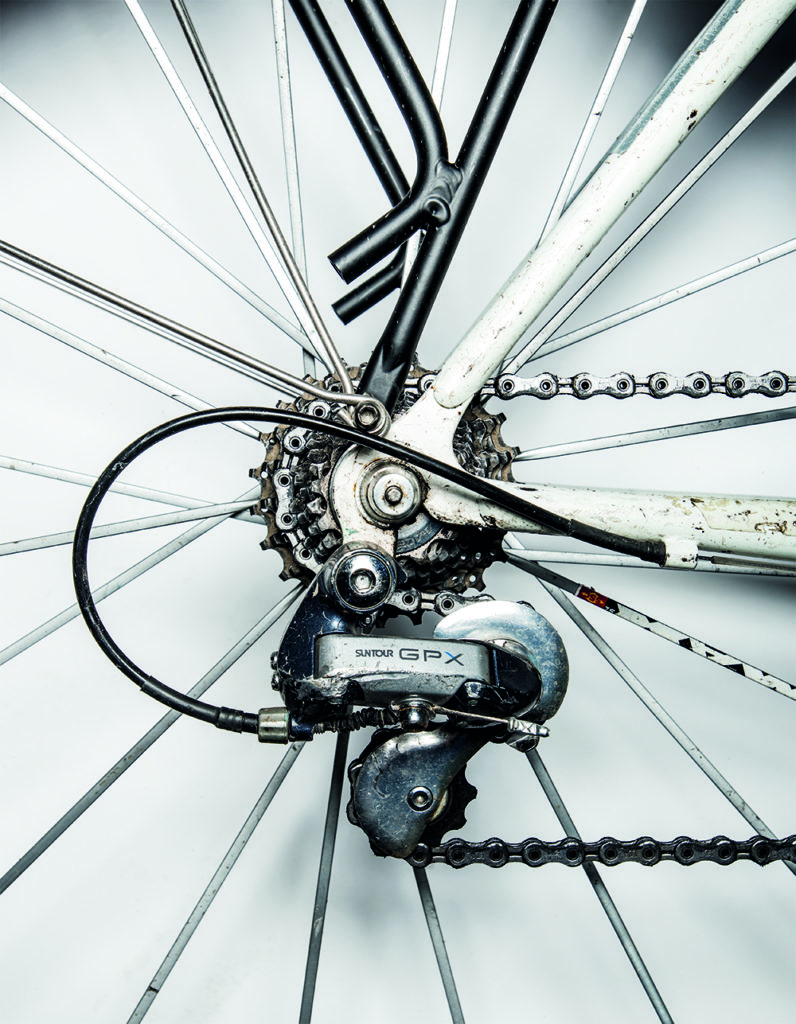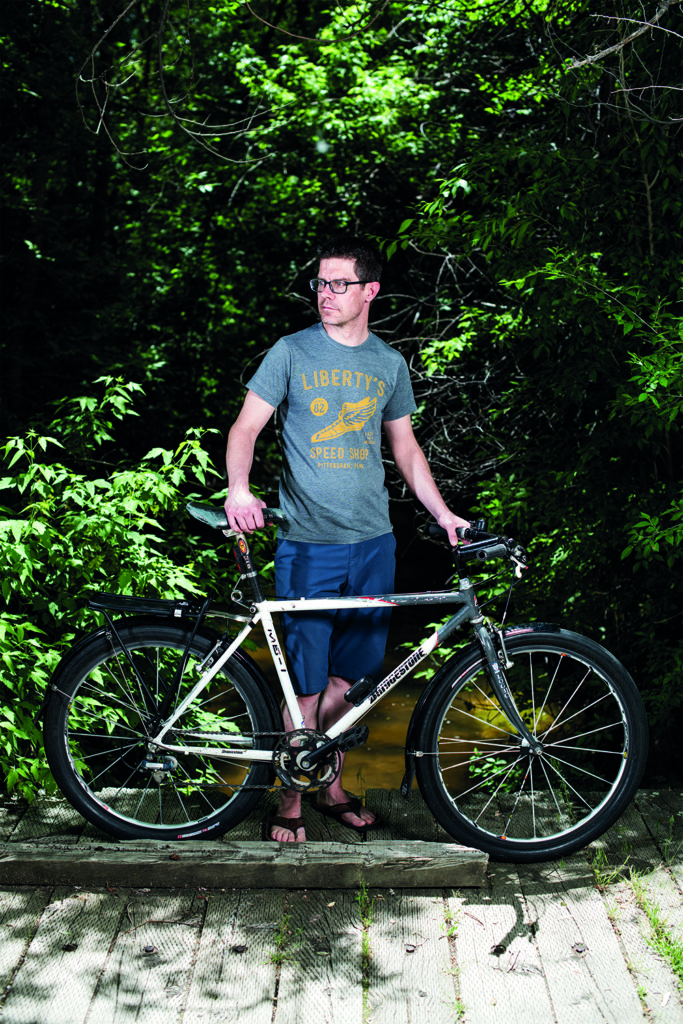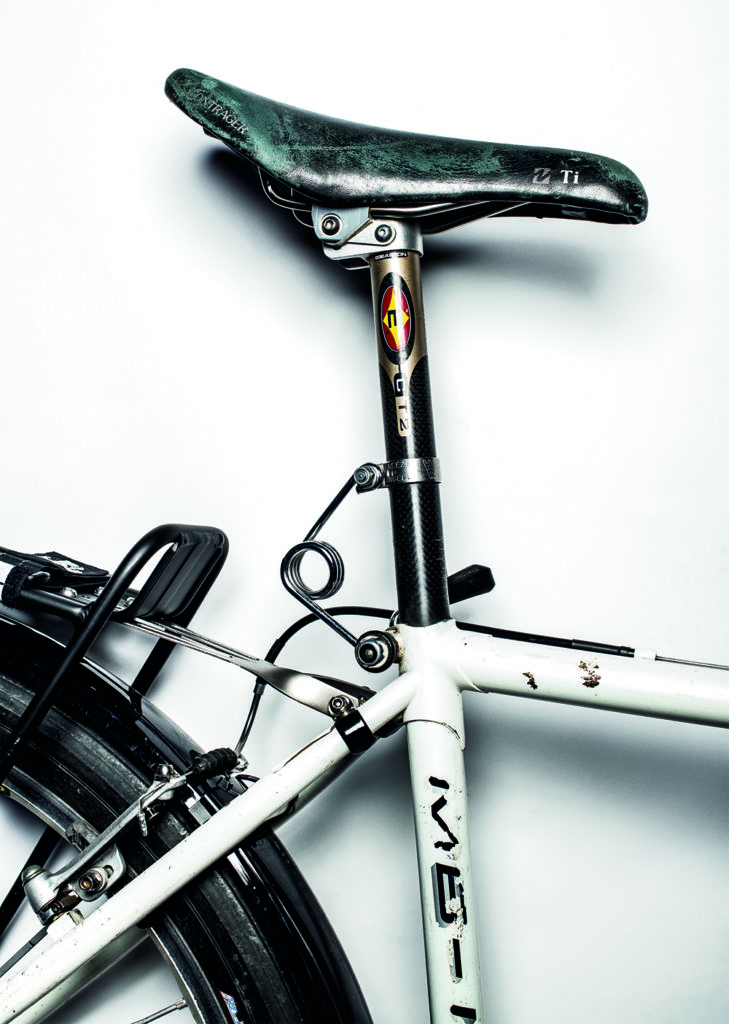The First Bike I Really Loved… And All The Reasons Why
I have owned it for 27 years. When I bought it new, I never dreamed where it would take me, and what it would come to mean to me.
The bike is old now, and not much to look at. The white and grey paint is scratched and gouged in too many spots to count. The parts are a curious mishmash of swish upgrades from 15 years ago, and second-hand near-junk bought at a local charity shop. That dashing red chevron on the top and down tube that seemed so fetching to me all those years ago? Time and decay have revealed it to be not paint, but rather a cheap, unprotected decal. Same for ‘Bridgestone’ and ‘MB-1’.
This is my old mountain bike, currently my townie, my jalopy. I own 6.5 bicycles (the half is a shared dirt jumper). But if all were lost tomorrow in a fire, the one I would mourn the most is the most dilapidated runner in the bunch. I have owned it for 27 years. When I bought it new, I never dreamed where it would take me, and what it would come to mean to me.
I bought it for $1 100 (currently R15 000) in the spring of 1991, with a matric-pass cheque from my folks and money scraped together from my minimum-wage income from a fast-food joint.

I’d been riding bikes seriously for three years at that point, entering local criteriums and a stage race with inauspicious results. I had a decent road bike, but I was roosting around local greenbelt singletrack and BMX parks on a clapped-out ATB Trailmaster Dad bought at a department store for R1 000.
I’d managed to bend the fork and put a large dent in the rear rim bunnyhopping kerbs, which of course meant I needed nicer equipment to trash.
Pretty quickly, I decided it must be a Bridgestone. Which one, exactly, changed throughout winter and spring, as I saved. I started with sights set on the MB-3, a sturdy, serviceable machine, around R9 500. Soon, I talked myself up to the R12 000 MB-2. Upgrades, you know.
In a dog-eared catalogue I cadged from the local dealer, I made detailed notes on spec differences. Before long, I’d rationalised my way to the MB-1. Hand-brazed in Japan, it had a full Ritchey Logic Prestige frame – double-butted tubes throughout for lighter weight. Important, right? It was also the furthest my financial reach would grasp. Yes, the fabled MB-0, made for only two years and even today the subject of spirited eBay bidding, was the bike I deserved, I told myself. But it was R20 000 (about R38k, in today’s money): reserved for tax brackets well above the minimum-wage rewards of heating up burgers and chips.
So, MB-1 it was. The summer day I brought it home, one of my friends had a school-leaving party, and I rode the bike there. Doug and Jill and Eric and Monica and the Kevins gathered around to offer appreciation; but most vivid to me now was my hot fear and anger after Doug crashed my new bike trying to pop a wheelie. Thankfully, the bike was undamaged. So was Doug, I think.
While I’d dabbled in road racing, I had yet to try the fast-growing XC discipline. Finally I had a bike worthy of it, and that summer I entered my first MTB race at a local park. There were maybe 10 of us in the junior Sport category that day. Given my unpromising road racing results, I had low expectations. I started poorly, as usual. But the race was three times around a short-ish lap with one big climb, and if there was one thing I could do, it was climb.
By the end of lap one I’d picked my way through half the field. After two laps, I was third, and in sight of the first rider. The last time up the climb, I put my head down and poured every ounce of myself into the pedals, passing one rider and then the second. At the crest, I was gloriously in the lead, with just a descent to the finish. Crossing a rut, I felt the rear tyre bottom hard, and then go soft. I tried to ride it out, but it was like pedalling over a wet mattress. One rider passed me back again, then the second. At the line, I was a heartbroken third.
Disappointment passed quickly, replaced by the intoxicating memory of near-success. Without the flat, I told myself, I’d have won. I perused a copy of VeloNews, and – presumably, still high on that post-race buzz – found what seemed like an appropriate next goal: a 24-hour solo race called Montezuma’s Revenge.

Why did I pick Bridgestone, a largely forgotten brand that lasted just over 10 years in the US? My memory of the paths not taken is hazy: I’m sure that I thought about Specialized, with its iconic Stumpjumper. Had I lived on the East Coast, the Cannondale M800 – the Beast of the East! – would’ve been a strong contender. I’m positive that I lusted after the Ritchey P-21. Although if the MB-0 was not in my price range, the handmade, fillet-brazed P-21, with its patriotic tricolour fade, was clearly beyond all hope.
As I look back now as a journalist who writes about bikes, it’s pretty clear why Bridgestone spoke to me: that catalogue. The brand stopped selling bikes in America after 1994. But in its day, it had an outsize reputation as an iconoclastic, quality brand known for sophisticated catalogues that glorified a complete lifestyle, decades before others thought about branded content or ambassadors.
Instead of just dry spec listings and geometry charts, the 1991 catalog was near magazine-like in length (40 pages) and content. It was all in colour, featuring action models and personalities like Karen the cycling marine biologist, Pineapple Bob, and Minnesota legend ‘Gene-O’. There were articles that wouldn’t be out of place today in this magazine: how to reduce your aero drag, what frame stiffness is and why it matters, and a two-page feature tutorial on cornering, with photos of a scandalously helmetless model.
I sought out and kept those annual catalogues, even after buying a bike, because they were more than just sales tools. I scrutinised Michael King’s body position in the piece on cornering technique. I eagerly read articles on gearing, or frame-building styles. A story on low-impact trail riding helped inspire my first journalistic feature: an essay for my high-school English class about mountain bikes and trail erosion. Those catalogues taught me as much about bikes, and cycling journalism, as reading Bicycling or VeloNews.
So why Bridgestone? Because the catalogues spoke to me as a 17-year-old finding his way on the bike and in the world, who didn’t know who he was but glimpsed in those pages a version of who he might want to be.
So, the Revenge. I was ignorant, undertrained, and wildly overmatched, with almost zero idea of what I was getting into. Montezuma’s Revenge was an absolutely idiotic, inspired idea: a 24-hour solo ‘mountain-bike odyssey’ starting and finishing in the tiny hamlet of Montezuma, Colorado, and almost entirely above 2 750m. (Clever motto: ‘You ain’t shit until you’ve had the Revenge!’)
The 290km-plus course was unmarked – riders simply had to learn it in advance – and unfinishable. Whoever got furthest on the nine different loops, with 10 crossings of the Continental Divide, was the winner. On one loop, racers hiked their bikes up a steep, rocky field to the summit of Gray’s Peak (4 352m) and back down another face, through a section of cliff bands. At night. After 160km of racing.
I knew about all that. Intellectually, that is. In theory. I trained all summer, mostly with long road rides, and scouted parts of the course the week before. But it didn’t matter: I got dropped almost immediately, and DNF’ed 120km in with excruciating knee pain. I failed to finish the next two years, as well. I failed in training. I failed in preparation, in planning, and in perseverance. I failed in so many ways. But the Bridgestone never failed. It was light and didn’t hold me back on the long climbs.
I rode the technical stuff in control and without crashing. The rigid fork was proven and reliable; even as I jackhammered over rocks and bumps, I never worried about it breaking. Looking back, after that first one I don’t even remember another flat tyre.
In the years after my Revenge failures, the Bridgestone transformed. Or, rather, the bike industry left it behind, forcing it to change. Full suspension began to finally deliver hints of its promise. Disc brakes, fatter steerer tubes, wider axle spacing followed. Steel was replaced by aluminium, and then carbon fibre.
I still rode and raced my MB-1, but eventually a sandy cross-country event destroyed the drivetrain. Even cleaned, it never shifted properly. Obsolete and expensive to revive, the MB-1 could have been junked. Instead, it adapted. The single-speed fad was in its infancy and I was intrigued by its sense of fun, which seemed to have gone missing from traditional XC racing. So with Paul Component’s then-new WORD (Wacky One-Speed Rear Device) hub and a Surly Singleator, the Bridgestone and I joined the one-speeder club. Not long after, I left the only real job I’ve ever had, and moved back to Boulder, where single-speed was both a bike and a social scene.
It wasn’t just single-speeding’s simplicity that appealed to me; it was its absurdity – why would you have just one gear?! That was highlighted by activities like the Wednesday lunch rides with a local single-speed crew called the Intergalactic Pilots, which included stunts like riding in teams of two with bikes tied together with rope.
Single-speeding enabled my favourite approach to riding, best described as quirky. Rather than today’s cookie-cutter industrial singletrack, I like quiet, small, tight trails where you descend no faster than you climb. Instead of signs, I prefer trailside shrines made of pop culture objects, like the metre-tall plastic Pooh Bear on one trail, and a rubber foot in a tree on another. And the best rides are the ones where I can go for hours and see more deer than people.
Eventually, the single-speed fad faded (it really is the wrong gear, all the time), and the rigid fork grew more obnoxious than eccentric on technical trails.
The Bridgestone’s one-inch steerer tube made it effectively impossible to add any kind of suspension, in a landscape of 11/8-inch and tapered steerer tubes.
So it transformed again. After a couple years of rest in my garage, I converted it to a 10-speed utility bike. It’s my ride of choice for grocery runs, errands, and avoiding the shitshow that is parking in Boulder when I meet friends on Pearl Street for a beer. I put a rear rack on and unearthed an old set of Mountainsmith panniers to expand its hauling capacity. For about six months last year, I even did an e-bike conversion with a Copenhagen Wheel, a seamless, simple process that said as much about the bike’s adaptability as it did the Wheel’s design. And being a Bridgestone, with a somewhat eclectic parts mix, in a bike-mad town like Boulder, it also serves as a conversation piece. When I bought it, I’d ride it almost daily. And now, I do so again.

‘Cruiser’ might be the MB-1’s final incarnation, but as it’s lived at least three lives till now, who can say? When I swapped the parts for cruising, I took a moment to appreciate, again, the practical, restrained wisdom in its creation. Even in 1991, bikemakers were quietly eliminating stuff from frames that added weight or cost, like mudguard eyelets. But because Bridgestone kept them, I can add mudguards without ugly, cumbersome clip-on brackets. Its standard, English-thread bottom bracket shell means parts are still easy to find. And because it’s steel, I can always cold-set the rear triangle to accept slightly wider axles.
I have owned, and sold, other bikes that to a stranger would have far more value. And I have other bikes with that ‘forever bike’ status: a gorgeous steel Pegoretti, an iconic Raleigh team track bike.
Like the Bridgestone, they have sentimental value to me. But in those cases, there are sort-of-rational explanations for their forever-bike status that would make sense to another cyclist. The Bridgestone? Maybe to a few of us who remember the brand as I do. But to most, the first reaction is, “Don’t they make car tyres?”
It’s not pretty, with scratched and gouged paint and faded and peeling decals. The parts are often cheap used stuff, like a second-hand Suntour GPX rear derailleur, or the Deore XT thumbshifters, which I bought because they have a friction mode, which means the drivetrain never needs adjusting. There’s a ‘Made in Hungary’ sticker on the head tube that someone slapped on long ago as a joke. When I ride no-hands, there’s a subtle but unmistakeable speed wobble up front. And because it’s old, it may very well break one day when I ride it off a curb with a full load of groceries in the panniers.
And yet, this least of bikes, this unremarkable leftover, this kludged-together… thing, is my most treasured two-wheeled possession. When we were both new – to cycling, to adulthood – the future was bright, clear, and clean. No doubt, no losses to scar us, no questions of identity and self-worth that come with age and experience and failure. Time has brought plenty of those. But each challenge has been met not with retrenchment, but with reincarnation, adaptation, and acceptance.
A quarter of a century ago, I harboured vague and unrealistic dreams as a racer. Thankfully, I failed to achieve them. Had I succeeded, I might have discarded the Bridgestone for a new ride when technology overtook it. Had I not found the catalogues, perhaps I would not have chosen journalism. I love this bike not because of what it is, but because of what we – it and I – are together. What we’ve been through. What we’ve become. And what we may yet be.
READ MORE ON: bridgestone first bike gear

